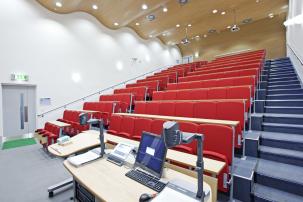Teaching and learning
How do we organise our teaching?
 We offer about 70 different modules in various areas of pure, applied and computational mathematics and statistics. Most modules are based around a series of lectures, but there are also some reading and project modules that involve more self-directed study.
We offer about 70 different modules in various areas of pure, applied and computational mathematics and statistics. Most modules are based around a series of lectures, but there are also some reading and project modules that involve more self-directed study.
Lectures take place in our Maths lecture theatre (pictured above left) and in other venues around campus. Lecturers will use a variety of different media to teach, ranging from notes written on a blackboard, whiteboard or visualiser to computer-based presentations and videos. Lecture notes, exercises and solutions are  available in QMPlus, our Virtual Learning Environment, for most of our modules.
available in QMPlus, our Virtual Learning Environment, for most of our modules.
Students normally take 8 modules per year as 4 modules per semester. Most modules comprise 3 hours of lectures plus 1 hour of exercise class or computing laboratory per week, which corresponds to about 4 × 4 = 16 timetabled hours of teaching per week.
How will you be assessed?
Most modules are assessed primarily by a written exam at the end of the academic year in May or June, although for modules in the first and second years there is usually a contribution of about 10% from assessed coursework or tests. Students are allowed 2 attempts at each exam but the second attempt is a resit in August which is capped at a pass mark.
What must you do to progress?
Essentially, you must pass 7 out of 8 modules to progress to the second year; a total of 14 out of 16 modules to progress to the third year, and a total of 21 out of 24 modules to be awarded a BSc degree.
How do we classify your degree?
We use a weighted average of all your module marks as the basis for awarding you a first, upper-second, lower-second or third class degree. The first, second and final years count with weights respectively 1:3:6 towards the BSc degree classification.
Please note that all information on these webpages are for guidance only. For full details of our assessments, marking and progression criteria, please see QMPlus or your student handbook.